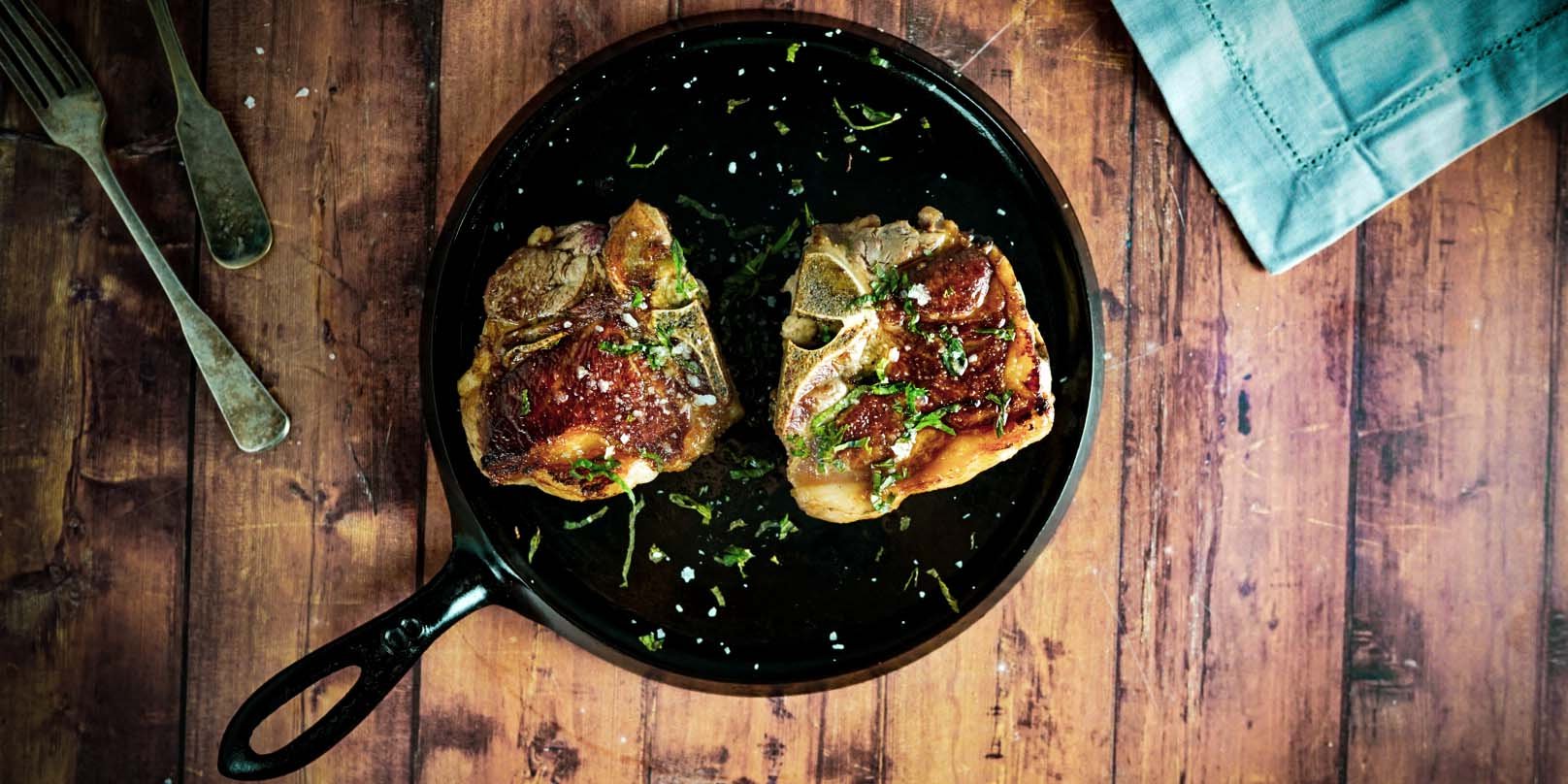Our grassfed lamb comes from animals who were raised on pasture, as they were intended to. We are committed to the welfare of our animals, who were born to roam and graze.
Small ruminants, like sheep and goats, are an essential part of a multispecies grazing system. Our sheep help us regenerate land with their animal impact. Our sheep graze everywhere from the forest land bordering our pastures to underneath solar panels at nearby solar farm Silicon Ranch.
What's the difference between conventional and grassfed lamb?
Much of the lamb available in the United States is grain-finished in commercial feedlots.
- This means that these sheep spend the last part of their lives eating lots of calorically-dense grain to gain weight very quickly.
- This confined feeding operation leads to lamb with lots of dense fat, which may carry a strong, gamey flavor.
White Oak Pastures sheep live on a strictly forage (grass) diet and are very active.
- They use their muscles to forage and access water, burning calories and fat.
- This creates a leaner, less fatty product.
- Our customers tend to find our lamb sweeter and milder than commercial feedlot lamb.
Grassfed lamb is a beautiful thing to cook with in the kitchen.
Our farm is committed to zero waste practices, meaning that any part of the animal we can't sell to customers, we turn into products like pet chews and leather, or we compost and return the nutrients to our soils. Our focus on zero waste also includes helping our customers make the most out of every cut of meat they buy from us.
Grassfed Lamb Cooking Tips
Grassfed lamb has a great, balanced fat content, which allows it to be cooked in a variety of ways while remaining tender and moist. Because of the active lifestyle of our grassfed lamb, the meat has a sweet, earthy, and mild flavor.
Lamb meat has a distinctive flavor that goes well with robust spices and herbs.
Whether you’re seasoning the meat, creating sauces, or choosing side dishes, here is a (nonexhaustive) partial list of our favorite spices and flavor profiles that pair well with lamb:
- Mint
- Lemon zest or peel
- Cumin
- Rosemary
- Garlic
- Black pepper
- Oregano
- Fenugreek
- Turmeric
- Cloves
- Curry blends
- Baharat blends
What are your favorite seasonings for lamb? Leave your ideas in the comments below!
Read on to learn more about our favorite tips and recipes. Whether you’re new to grassfed lamb or you’re looking for recipe inspiration, this guide will help you on your way with recipes for some of our most popular cuts of lamb.
How To Perfectly Cook Grassfed Lamb, By Cut
Click below to skip to a section or scroll down:
- Grill, Pan Fry, or Bake: Rib Chops, Loin Chops
- Slow Cook or Braise: Center Cut Leg Roast, Lamb Shoulder, Roasts
- Slow Roast: Denver Ribs
- Substitution in Your Favorite Recipe: Ground Lamb, Lamb Stew Meat
Grill, Pan Fry, or Bake: Rib Chops, Loin Chops
Grassfed lamb rib and loin chops are the equivalent to a grassfed steak, making them some of the most popular cuts of lamb. Chops are easy to prepare, cook quickly, and the mild, sweet flavor is a great foundation for accompanying sauces.
Rib or loin chops can be cooked on the grill, pan fried in oil, or baked in the oven.
In many ways, the preparation is similar to cooking a grassfed steak. A few cooking tips, no matter how you prepare the rib or loin chops:
- Always pull the lamb from the refrigerator and bring to room temperature before cooking.
- We recommend preparing grassfed lamb to medium rare (145°F), and we don’t recommend going over medium (155°F).
- As with grassfed steak, pull the loins when they register 10°F LOWER than your desired temperature. The meat will continue to cook while it is resting.
- Let the meat rest for 10 minutes before cutting, which allows the juices to redistribute.
- When serving, slice meat against the grain.
For grassfed lamb rib and loin chops, try this recipe:
Slow Cook or Braise: large cuts like Center Cut Leg Roast, Lamb Shoulder
A large lamb roast is an impressive centerpiece for a meal. A roast is dense but rich, pairing well with lots of herbs or a strong spice mix.
Because a roast is a large cut with lots of fat and connective tissue, it is best cooked low and slow under moist heat. Roasting or braising a lamb leg or shoulder liquefies the collagen and fat to coat the muscle fibers, making a deeply flavorful, tender result.
We recommend cooking a lamb roast until 135°F for medium rare, which means you should pull it when the thickest part registers 120-125°F (it will continue cooking as it rests). After braising or slow cooking, quickly broiling the outside or searing in a pan can give a crispy finish.
For grassfed lamb roasts, try this recipe:
Slow Roast: Denver Ribs
"Denver Ribs" are lamb spareribs, the lower 7 to 8 ribs usually with the fat, gristle, and connective tissue removed. Denver Ribs are a leaner alternative to pork ribs, and with a big flavor, they're delicious with or even without a dipping sauce.
Like spareribs, Denver Ribs can be cooked with dry heat, barbecued, or slowly braised in moist heat and finished with high heat for a crispy exterior.
For grassfed lamb ribs, try this recipe:
Substitution in Your Favorite Recipe: Ground Lamb, Lamb Stew Meat
Lamb is extremely versatile in the kitchen. Ground lamb and lamb stew meat cook almost the same as ground beef, so substituting lamb for beef in many common recipes is an easy switch. If you're looking to cook more lamb, try:
- Changing out the protein in your favorite stew recipe
- Mixing in lamb to your meatloaf
- Using whole or half lamb meat in meatballs
- Creating lamb burger patties
Changing out beef for the sweet, mild flavor of lamb is an easy way to mix up classic recipes.
For ground grassfed lamb, try these recipe:
- Grassfed Ground Lamb Burger
- Lamb Meatballs with Lemon Mint Yogurt Sauce
- Spicy Grassfed Ground Lamb and Lentils with Herbs









